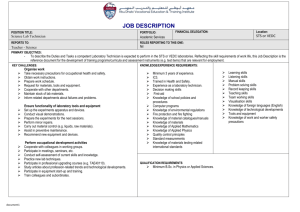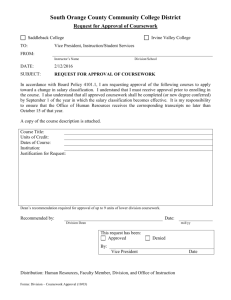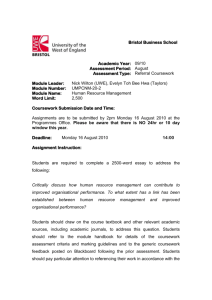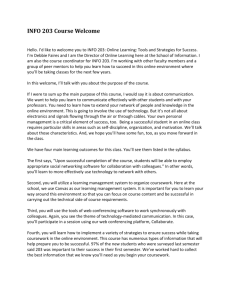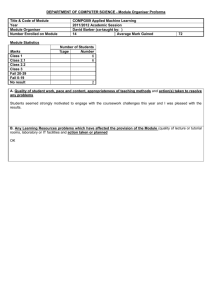Math, Science, and Technology: Essential Skills for
advertisement
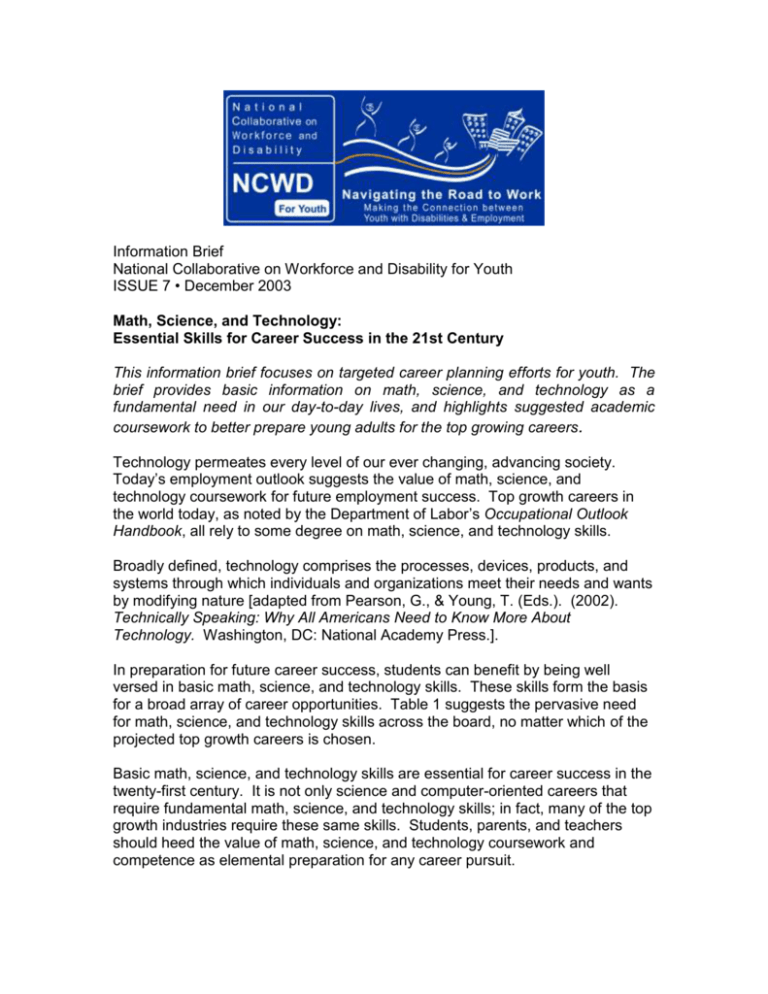
Information Brief National Collaborative on Workforce and Disability for Youth ISSUE 7 • December 2003 Math, Science, and Technology: Essential Skills for Career Success in the 21st Century This information brief focuses on targeted career planning efforts for youth. The brief provides basic information on math, science, and technology as a fundamental need in our day-to-day lives, and highlights suggested academic coursework to better prepare young adults for the top growing careers . Technology permeates every level of our ever changing, advancing society. Today’s employment outlook suggests the value of math, science, and technology coursework for future employment success. Top growth careers in the world today, as noted by the Department of Labor’s Occupational Outlook Handbook, all rely to some degree on math, science, and technology skills. Broadly defined, technology comprises the processes, devices, products, and systems through which individuals and organizations meet their needs and wants by modifying nature [adapted from Pearson, G., & Young, T. (Eds.). (2002). Technically Speaking: Why All Americans Need to Know More About Technology. Washington, DC: National Academy Press.]. In preparation for future career success, students can benefit by being well versed in basic math, science, and technology skills. These skills form the basis for a broad array of career opportunities. Table 1 suggests the pervasive need for math, science, and technology skills across the board, no matter which of the projected top growth careers is chosen. Basic math, science, and technology skills are essential for career success in the twenty-first century. It is not only science and computer-oriented careers that require fundamental math, science, and technology skills; in fact, many of the top growth industries require these same skills. Students, parents, and teachers should heed the value of math, science, and technology coursework and competence as elemental preparation for any career pursuit. RESOURCES The CareerOneStop website is a portal leading to America's Job Bank (AJB), America's Career InfoNet, and America's Service Locator. AJB lists available jobs. America's Career InfoNet provides information on wage and employment trends, occupational requirements, state-by-state labor markets, and general information on employers. America's Service Locator provides information on local One-Stop Career Center offices. http://www.careeronestop.org The CareerVoyages website features detailed information about the fastest growing industries and occupations; the skills and education required to prepare for them; job openings by area; and wages, licensing requirements and growth rates for numerous occupations. http://www.careervoyages.gov The US Department of Labor, Bureau of Labor Statistics (BLS) has a website designed for youth based on their interests in music and the arts, science, physical education and the outdoors, social studies, reading, and math. http://www.bls.gov/k12/html/edu_over.htm The Occupational Outlook Handbook, available on the BLS website, is a nationally recognized source of career information. The Handbook describes worker tasks, working conditions, necessary training and education, earnings, and expected job prospects for a wide range of occupations. http://www.bls.gov/oco/home.htm Table 1. Math, Science, and Technology Suggested Coursework for Top Growth Careers Astronomer Audiologist Biological or Medical Assistant Chiropractor Computer and Information Scientist Computer and Information Systems Manager Computer Software Engineer, Applications Computer Software Engineer, Systems Software Computer Support Specialist Database, Network, and Computer Systems Administrator Dental Assistant Desktop Publisher Medical and Health Services Manager Medical Assistant or Technician Medical Records and Health Information Technician Mental Health and Substance Abuse Social Worker Network Systems or Data Communications Analyst MATH SCIENCE Basic Computer Skills Advanced Computer Skills Higher Order Computer Skills Keyboarding COMPUTER Higher Order Science Physics Chemistry Biology General Science Higher Order Math Statistics SCIENCE Calculus Pre-calculus Geometry Algebra CAREER FIELD Basic Math MATH COMPUTER Occupational Therapy Assistant Optometrist Pharmacist Pharmacy Technician Physical Therapist Physical Therapy Assistant Public Relations Manager Respiratory Therapy Technician Speech Language Pathologist Surgical Technologist Telecommunications Line Installer Veterinarian Veterinary Technician Basic Computer Skills Advanced Computer Skills Higher Order Computer Skills* Keyboarding Higher Order Science* Physics Chemistry Biology General Science Higher Order Math* Statistics Calculus Pre-calculus Geometry Algebra Basic Math CAREER FIELD * Higher order skills include those required for analytical problem solving and critical thinking Note: The suggested math, science, and technology coursework is drawn from Bureau of Labor Statistics, US Department of Labor, Occupational Outlook Handbook, 2002-03 Edition, available online at http://www.bls.gov/oco, and from appropriate industry- and higher education-specified prerequisite coursework. The National Collaborative on Workforce and Disability for Youth is working to ensure that youth with disabilities are provided full access to high quality services in integrated settings to gain employment and independent living. NCWD/Youth is: Supporting state and local policies that promote full access to high quality services for youth with disabilities; Strengthening the services provided by organizations responsible for delivery of workforce development services; and, Improving the awareness, knowledge, and skills of individuals responsible for providing direct services to youth. PARTNERS Institute for Educational Leadership Academy for Educational Development InfoUse National Association of Workforce Boards National Center on Secondary Education and Transition, University of Minnesota National Conference of State Legislatures National Youth Employment Coalition TransCen, Inc. This Information Brief was written by Meredith Gramlich, M.A., and Lisa Cuozzo, M.A. To obtain this publication in an alternate format please contact the Collaborative at 877-871-0744 toll free or email Collaborative@iel.org. This Information Brief is the part of a series of publications and newsletters to be prepared by the NCWD/Youth. All publications will be posted on the Web site listed below. Please visit our Web site to sign up to be notified of future publications. This document was developed by the National Collaborative on Workforce and Disability for Youth, funded by a grant from the U.S. Department of Labor, Office of Disability Employment Policy (Grant Number E-9-4-1-0070). The opinions expressed herein do not necessarily reflect the position or policy of the U.S. Department of Labor. Nor does mention of tradenames, commercial products, or organizations imply the endorsement by the U.S. Department of Labor. Individuals may produce any part of this document. Please credit the source and support of federal funds. www.ncwd-youth.info
